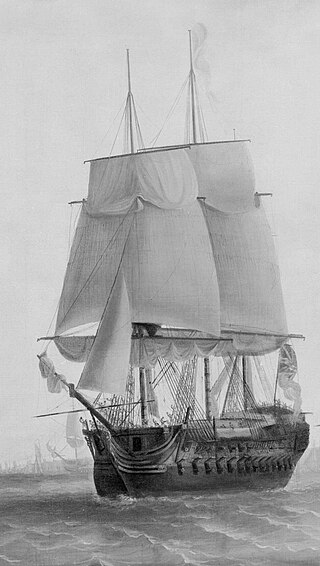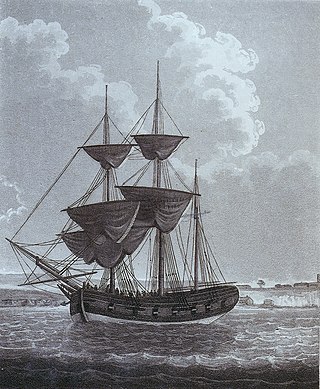

John May Sr or Jan Maij (1694 – 1779) was an English shipwright from Chatham who served from 1758-1779 as Master Shipbuilder of the Amsterdam Admiralty. [1]


John May Sr or Jan Maij (1694 – 1779) was an English shipwright from Chatham who served from 1758-1779 as Master Shipbuilder of the Amsterdam Admiralty. [1]
John May was hired in 1728 by the Amsterdam Admiralty. In 1727 this Admiralty, the largest of the five Dutch Admiralties, had hired Charles Bentham and Thomas Davis to work for them in improving ship design. [2] John May served as the assistant to Charles Bentam for three decades. [3] May taught the art of shipbuilding, and after the death of Bentam in 1758, he was appointed Master Shipbuilder and would serve in the position for 21 years. In 1761, May was accused of belonging to a camarilla with Count of Gronsveld which managed the Admiralty. [4] [5] [6]
In 1714 he married Rebecca Pensix (-1743) a spinster from Gillingham; [1] the couple had five children who lived to adulthood: Job, John, William, Rebecca, and George. In 1762, he married Magteld Geertruy Kannegieter of Amsterdam.
His son John May Jr or Johannes Maij (Rochester (1724-1782) married Martha Naudin in March 1753; the couple had five daughters. [7] At that time he lived at Reguliersgracht, but moved to Keizersgracht near Westerkerk. May traded in company with J.A. Crop on Narva, Reval and Riga, a decade later on the Caribbean. In March 1776, at the beginning of the American Revolutionary War, they shipped weapons and horses from Deptford to North-America. [8] During the Fourth Anglo-Dutch War he was pro-British, and the company liquidated in 1782. [9]
Job May, also a shipwright, owned the shipyard Yhoek on Wittenburg, which John bought in 1767. In 1790 it was sold by (his son-in-law) Isaac ten Cate who took over his business and involved in setting up a training for sailors. In 1793 John's daughter Elisabeth married Paul Busti, a real estate agent, operating the Holland Land Company in Philadelphia. [10]
William May (Maij) (Chatham 1725-1807), a captain and equipment master from 1780, devised various innovations in shipbuilding and cooperated with Robert Seppings. [11] He played a role on 30 May 1787 when the Admiralty was occupied and his house was besieged during the Patriot revolt. [12] He escaped with his family across the Y. [13] In December 1787 he appointed as captain of a civic guard. William was the father of Job Seaborn May, midshipman and Rear Admiral.
John May, Sr's designs in alphabetical order are: [14]
Twelve ships of the Royal Navy have borne the name HMS Thetis, named after the sea-nymph in Greek mythology:

Sir Robert Seppings, FRS was an English naval architect. His experiments with diagonal trusses in the construction of ships led to his appointment as Surveyor of the Navy in 1813, a position he held until 1835.

HMS Minotaur was a 74-gun third-rate ship of the line of the Royal Navy launched on 6 November 1793 at Woolwich. She was named after the mythological bull-headed monster of Crete. She fought in three major battles – Nile, Trafalgar, and Copenhagen (1807) – before she was wrecked, with heavy loss of life, in December 1810.

Courageux was a 74-gun ship of the line of the French Navy, launched in 1753. She was captured by the Royal Navy in 1761 and taken into service as HMS Courageux. In 1778 she joined the Channel Fleet, and she was later part of the squadron commanded by Commodore Charles Fielding that controversially captured a Dutch convoy on 31 December 1779, in what became known as the Affair of Fielding and Bylandt. On 4 January 1781, Courageux recaptured Minerva in a close-range action west of Ushant that lasted more than an hour. That April, Courageux joined the convoy under George Darby which successfully relieved the Great Siege of Gibraltar.

Caspar Stoll was a naturalist and entomologist, best known for the completion of De Uitlandsche Kapellen, a work on butterflies begun by Pieter Cramer. He also published several works of his own on other insect groups. Stoll's 1787 publication on stick insects, mantises, and their relatives is also well known. It was translated into French in 1813.

HMS Anson was a ship of the Royal Navy, launched at Plymouth on 4 September 1781. Originally a 64-gun third rate ship of the line, she fought at the Battle of the Saintes.
HMS Eurydice was a 24-gun Porcupine-class post ship of the Royal Navy built in 1781 and broken up in 1834. During her long career she saw service in the American War of Independence, the French Revolutionary Wars and the Napoleonic Wars. She captured a number of enemy privateers and served in the East and West Indies, the Mediterranean and British and American waters.
Eight ships of the Royal Navy have borne the name HMS Seagull or HMS Sea Gull, after the gull:

The Roebuck-class ship was a class of twenty 44-gun sailing two-decker warships of the Royal Navy. The class carried two complete decks of guns, a lower battery of 18-pounders and an upper battery of 9-pounders. This battery enabled the vessel to deliver a broadside of 285 pounds. Most were constructed for service during the American Revolutionary War but continued to serve thereafter. By 1793 five were still on the active list. Ten were hospital ships, troopships or storeships. As troopships or storeships they had the guns on their lower deck removed. Many of the vessels in the class survived to take part in the Napoleonic Wars. In all, maritime incidents claimed five ships in the class and war claimed three.

HMS Wolverine, was a Royal Navy 14-gun brig-sloop, formerly the civilian collier Rattler that the Admiralty purchased in 1798 and converted into a brig sloop, but armed experimentally. She served during the French Revolutionary Wars and participated in one action that won for her crew a clasp to the Naval General Service Medal. A French privateer captured and sank Wolverine on 21 March 1804 whilst she was on convoy duty.

HMS Brilliant was a 36-gun Venus-class fifth-rate frigate of the British Royal Navy that saw active service during the Seven Years' War with France. She performed well against the French Navy in the 1760 Battle of Bishops Court and the 1761 Battle of Cape Finisterre, but was less capable when deployed for bombardment duty off enemy ports. She also captured eight French privateers and sank two more during her six years at sea. The Royal Navy decommissioned Brilliant in 1763. The Navy sold her in 1776 and she became an East Indiaman for the British East India Company (EIC). Brilliant was wrecked in August 1782 on the Comoro Islands while transporting troops to India.

The Dutch ship sloop Havik was launched in 1784 and served in the Batavian Navy. The British captured her in 1796 at the capitulation of Saldanha Bay. She then served briefly in the Royal Navy as HMS Havick before she was wrecked in late 1800.
The Dutch sloop Sireene was launched in 1786. The British captured her in 1796 at the capitulation of Saldanha Bay. She then served in the Royal Navy, first briefly as the sixth rate HMS Daphne, and then from 1798 as the prison ship HMS Laurel. The Admiralty sold her in 1821.

HMS Dolphin was a 44-gun fifth rate ship of the Royal Navy launched in 1781. Designed by Sir Thomas Slade, she carried her armament on two decks and had a main battery of 18-pound long guns. She made an appearance at the Battle of Dogger Bank in 1781. The rest of her 36-year career was uneventful, much of it being spent as a transport or hospital ship, armed only with twenty or twenty-four, 9-pounders. She was broken up at Portsmouth in 1817.

HMS Roebuck was a fifth-rate ship of the Royal Navy which served in the American and French Revolutionary Wars. Designed in 1769 by Sir Thomas Slade to operate in the shallower waters of North America, she joined Lord Howe's squadron towards the end of 1775 and took part in operations against New York the following year. She engaged the American gun batteries at Red Hook during the Battle of Long Island in August 1776, and forced a passage up the Hudson River in October. On 25 August 1777, Roebuck escorted troopships to Turkey Point, Maryland, where an army was landed for an assault on Philadelphia. She was again called upon to accompany troopships in December 1779, this time for an attack on Charleston. When the ships-of-the-line, which were too large to enter the harbour, were sent back to New York, Admiral Marriot Arbuthnot made Roebuck his flagship. She was, therefore, at the front of the attack, leading the British squadron across the shoal to engage Fort Moultrie and the American ships beyond.
HMS Diana was variously described as a brig or cutter. Her origins are currently obscure, but the British Royal Navy acquired her at Bombay in 1807. In her short career she captured three armed vessels, one in a notable single-ship action. She was condemned in 1810.
HMS Hermes was the Dutch cutter Mercuur, that the Amsterdam Admiralty purchased in 1781 or 1782. HMS Sylph captured her off the Texel on 12 May 1796 after a chase during which Mercuur threw all but two of her guns overboard.